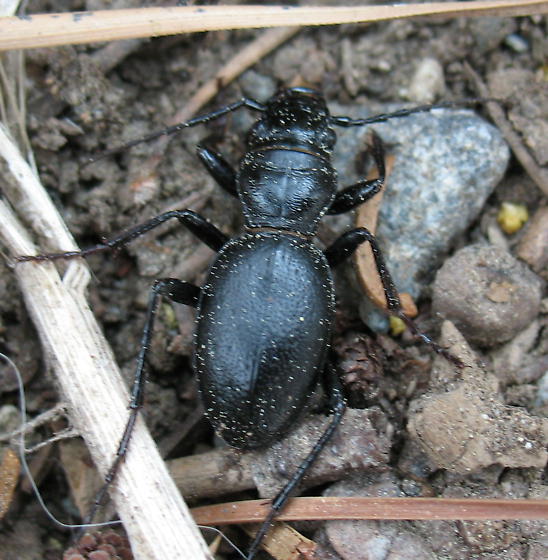Form and Function
Throughout time and evolution there is a lot of ways Omus
californicus or the California Night-stalking Tiger Beetle
adapted its form and function to best suit the environment. To
begin, they are small creatures overall averaging from 15 to 21
millimeters long (Wirth et al. 2005). This is fairly large for an
insect, and there are few bugs that are larger within the same
habitat so the Tiger Beetle fears bigger predators. Because they
are large beetles they have been known to be one of the fastest land
dwelling arthropods on the planet (Kamoun and Hogenhut 1996). This
speed helps them to capture prey increasing food supplies and
survival; this speed also helps tiger beetles to evade predators.
Omus californicus also has many other ways or
mechanisms that help it survive and thrive in the habitat, including
body color and size, fleeing response to sound, chemical defenses,
group mentality, and sometimes flight (Schmidt 2013). Flight, though
is not found in the genus Omus of Beetles is found in all
other genera (Wirth at el. 2005). All of these mechanisms have
evolved through time, in response to certain predators. The color of
their body plays a huge roll in the survival of the California
Night-stalking Tiger Beetle. Since all of their active life is spent
at night on the ground in leaf litter, being the color black or
extremely dark brown helps to blend into the background (Wirth at
el. 2005). Being relatively small aids in the ability to hide in
small places under dead trees and leaf litter. Another thing that
helps Tiger Beetles survive in the environment is their acute sense
of hearing and the ability to flee quickly once something is heard.
This also helps them avoid predators by not letting them sneak up on
them.
 Like a lot of smaller bugs, the California
Night-stalking Tiger Beetle has developed a chemical defense, which
releases toxins from a special pygidial gland. There are three main
chemicals that were found to be used by Tiger Beetles: they are
mandelonitile, hydrogen cyanide, and benzaldehyde. The main chemical
found throughout the tiger beetles is the benzaldehyde (Blum at el.
1981). Benzaldehyde is an almond smelling scented aldehyde that is
sprayed out into the air to block the chemoreceptors found in the
antennas of other predatorily invertebrates (Kelley and Schilling
1998). By blocking the chemoreceptors, it makes it hard for the
predator to locate the Tiger Beetle. The use of hydrogen cyanide is
used to help defend it from vertebrae predators because it will make
them sick if they eat the beetle when the chemical is released. To
survive in their environment, it helps them to have a group
mentality and stay in the group. This helps when there are predators
near by because they will all be able to let off their chemical
defenses. When they all release these chemicals, it will be more
noticeable for predators in the area and make it less likely for
them to find them with the chemoreceptors or have the want to eat
them.
Like a lot of smaller bugs, the California
Night-stalking Tiger Beetle has developed a chemical defense, which
releases toxins from a special pygidial gland. There are three main
chemicals that were found to be used by Tiger Beetles: they are
mandelonitile, hydrogen cyanide, and benzaldehyde. The main chemical
found throughout the tiger beetles is the benzaldehyde (Blum at el.
1981). Benzaldehyde is an almond smelling scented aldehyde that is
sprayed out into the air to block the chemoreceptors found in the
antennas of other predatorily invertebrates (Kelley and Schilling
1998). By blocking the chemoreceptors, it makes it hard for the
predator to locate the Tiger Beetle. The use of hydrogen cyanide is
used to help defend it from vertebrae predators because it will make
them sick if they eat the beetle when the chemical is released. To
survive in their environment, it helps them to have a group
mentality and stay in the group. This helps when there are predators
near by because they will all be able to let off their chemical
defenses. When they all release these chemicals, it will be more
noticeable for predators in the area and make it less likely for
them to find them with the chemoreceptors or have the want to eat
them.
As young, they even have some functions that help them attain
food. When they eat, they simply lay on the edge of the parent’s
turrets which attract prey to the entrance so the larva can eat
(Schmidt 2013). The larva catches the bugs like flies and spiders
at the entrance of the cave with their mouth. They have hooks on
their abdomen that keep them hooked in the mouth of the cave. This
hook allows them stay in the cave so they cannot be dragged out and
consumed themselves (Schmidt 2013). These are just a few examples
as to how the extremely fascinating California Night-stalking Tiger
Beetle evades predators and attacks prey; an organism that has all
these great functions to help it survive in the wild.
Page Created by Cameron Terrell